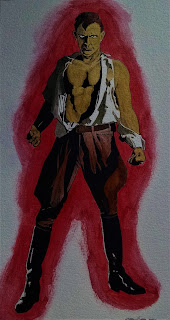LEGENDARY HEROES #12
DOC SAVAGE - MAN OF BRONZE
Street & Smith Publications had recently struck gold with their pulp magazine creation of The Shadow and wanted to capitalize on that success with yet another character. Publisher Henry W. Ralston and editor John L. Nanovic came up with the idea of Doc Savage. Nanovic wrote a short premise outlining the character but it was left to writer Lester Dent to fully flesh out the hero. Of the 181 short novels that were produced on a monthly basis, Dent, under the house name Kenneth Robeson, wrote 159 of them. Lester Dent (1904-1959) was paid $500 a month by Street & Smith and this was later increased to $750, which was damn good money during the Depression. Dent stated that he had no illusions of being a great author and that for him Doc Savage was simply a job "churning out reams and reams of sellable" product. But the money he earned made it possible to buy a yacht and to vacation in the Caribbean. Doc Savage debuted in his own magazine in March 1933 and concluded in the Summer 1949 issue. The character was born Clark Savage, Jr. who became known as "Doc" to his friends.
From the time of his birth Clark Savage was raised to become the perfect human being. His father assembled a team of scientists who trained the young boy's mind & body to near superhuman ability, giving him great strength and endurance, a photographic memory, mastery of martial arts, and a vast knowledge of all the sciences. Doc Savage was a physician, scientist, adventurer, detective, inventor, explorer, and researcher. When his father was murdered Doc dedicated his life to righting wrongs and punishing evildoers. He became known as the Man of Bronze because of his sun-bronzed skin. Doc established his base of operations on the 86th floor of the Empire State Building which he accessed by a high-speed elevator. He was aided by the "Fabulous Five", a group of assistants who had such varied backgrounds as an industrial chemist, an attorney, a construction engineer, an electrical engineer, and an archaeologist & geologist. Their headquarters was linked to a secret hangar on the Hudson River which stored a fleet of cars, trucks, aircraft and boats under the name of The Hidalgo Trading Company. Doc Savage also had an Arctic hideaway he called The Fortress of Solitude, and this was 5 years before the creation of Superman. Doc and the Five often dealt with the supernatural and paranormal that usually had a rational explanation, like conventional criminals scaring the locals away to conceal their evil deeds.
Like "The Shadow", Street & Smith was hoping to reach an even bigger audience through radio and debuted a Doc Savage radio series in 1934. The show consisted of 15-minute episodes but it failed to catch on with listeners and ended after only 26 shows. In 1943 a second attempt was made on radio, but this character was not based on the pulp Doc Savage but rather a comic book version that differed greatly from the original. In 1940 Street & Smith had launched a Shadow comic book to attract a younger audience to their pulp character. Each issue of the comic book started off with a Shadow story, then included comic stories of their other pulps. Doc Savage was one of these, and he was given his own comic book in May 1940. Originally the stories were based on the pulp magazines but in issue #5 that all changed. Doc crashes a plane in the Tibetan mountains where he is rescued by mysterious monks who give him a blue hood to wear with a sacred ruby placed in the forehead. The ruby deflects bullets and hypnotizes people who gaze into it, and the comic Doc Savage becomes a costumed superhero. The comic book ended in 1943 after only 20 issues and Doc returned to the pages of The Shadow comic book. In 1966 Gold Key comics published a one-shot issue that was an adaptation of a planned movie that was to star Chuck Connors as Doc Savage...but the movie was never filmed.
Doc Savage had a huge resurgence in 1965 when Bantam paperbacks began reprinting the entire pulp series with fantastic covers done by illustrator James Bama who updated Doc's appearance by giving him an exaggerated widow's peak that made his hair look like a helmet. Bantam published a book a month until the last of the original 181 stories was printed in 1990. The series was hugely successful and Bantam sold over 20 million copies of Doc Savage paperback books. Based on this success, in 1975 a film was made with Ron Ely of Tarzan fame appearing as Doc Savage. But the movie was a critical and box-office failure. Producer and director George Pal decided to make the film in the same high-camp style as the 1966 "Batman" TV series and fans of the novels hated it. A second film and TV series were planned as well, but after the poor reception that the first movie received these plans were scrapped. Perhaps the greatest testament to Doc Savage is the overall impact and influence the character had on later heroes. Doc had a Fortress of Solitude in the Arctic, just as Superman would also. Doc was the Man of Bronze, and Superman became the Man of Steel. In early issues of the pulp magazine Doc was referred to as a "superman". As Stan Lee of Marvel comics rightfully acknowledged, Doc Savage was the First Superhero.


.jpg)

.jpg)
Comments
Post a Comment